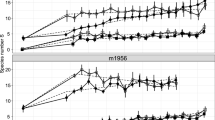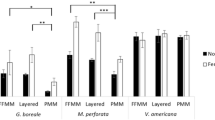Abstract
The seedling establishment of late colonizer may be promoted in the environments created by the early colonizer without interspecific seedling competition. To confirm the hypothesis, seed-sowing experiments were conducted in a post-mined peatland, northern Japan. Seeds on three grasses (Rhynchospora alba, Moliniopsis japonica and Phragmites australis) were sown in four vegetation sites: bareground, R. alba grassland, M. japonica grassland, and grassland mixed with three examined species. R. alba is the earliest colonizer, and M. japonica and P. australis are the later ones. Seedling emergence, survival, growth and resource allocation were monitored for two growing seasons. The seedling emergence of all the species was lowest on bareground. The emergence of R. alba and P. australis was high in R. alba and mixed grasslands, but was low in M. japonica grassland. M. japonica seedlings emerged more in vegetation with moderate plant cover and litter. R. alba seedlings yielded the highest biomass on bareground, and the biomass decreased with increasing shading. R. alba did not change resource allocation of height to above-ground biomass between vegetation types. The seedling biomass of M. japonica was affected little by shading, probably because M. japonica adjusted resource allocation with shading. In the two summers, R. alba and M. japonica seedlings survived more when the neighboring seedlings emerged more. P. australis seedlings failed in overwintering. The seedling characteristics of each species explained the species replacement, i.e., R. alba invaded bareground and facilitated the establishment of late colonizer, M. japonica, by the shelter effects of the overstory and seedling.




Similar content being viewed by others
References
Anderson JT (2009) Positive density dependence in seedlings of the neotropical tree species Garcinia macrophylla and Xylopia micans. J Veg Sci 20:27–36
Campbell DR, Rochefort L (2003) Germination and seedling growth of bog plants in relation to the recolonization of milled peatlands. Plant Ecol 169:71–84
Campbell DR, Lavoie C, Rochefort L (2003) Wind erosion and surface stability in abandoned milled peatlands. Can J Soil Sci 82:85–95
Egawa C, Koyama A, Tsuyuzaki S (2009) Relationships between the developments of seedbank, standing vegetation and litter in a post-mined peatland. Plant Ecol 203:217–228
Fargione J, Tilman D (2005) Niche differences in phenology and rooting depth promote coexistence with a dominant C4 bunchgrass. Oecologia 143:598–606
Fayolle A, Violle C, Navas ML (2009) Differential impacts of plant interactions on herbaceous species recruitment: disentangling factors controlling emergence, survival and growth of seedlings. Oecologia 159:817–825
Fenner M, Thompson K (2005) The ecology of seeds, 1st edn. Cambridge University Press, Cambridge, pp 155–159
Girard M, Lavoie C, Theriault M (2002) The regeneration of a highly disturbed ecosystem: a mined peatland in sourthern Quebec. Ecosystems 5:274–288
Kleijin D (2003) Can establishment characteristics explain the poor colonization success of late successional grassland species on ex-arable land? Restor Ecol 11:131–138
Lambers H, Chapin FS III, Pons TL (1998) Plant physiological ecology, 1st edn. Springer, New York
Mauchamp A, Blanch S, Grillas P (2001) Effects of submergence on the growth of Phragmites australis seedlings. Aquat Bot 69:147–164
Nishimura A, Tsuyuzaki S, Haraguchi A (2009) A chronosequence approach for detecting revegetation patterns after Sphagnum-peat mining, northern Japan. Ecol Res 24:237–246
Oka T, Igarashi Y, Hayashi M (2005) Study of the alluvial deposits (alluvium) in the Teshio plain by analyzing drilling data and pollen analysis. Geol Surv Hokkaido Rep 77:17–75
Prince JS (1996) Hydrology and microclimate of a partly restored cutover bog, Quebec. Hydrol Process 11:1263–1272
Ryser P (1993) Influences of neighboring plants on seedling establishment in limestone grassland. J Veg Sci 4:195–202
Salonen V, Setälä H (1992) Plant colonization of bare peat surface–relative importance of seed availability and soil. Ecography 15:199–204
SDMO (Sapporo District Meteorological Observatory) (2008) http://www.sapporo-jma.go.jp. Accessed 25 Mar 2008
Skinner RH (2005) Emergence and survival of pasture species sown in monocultures or mixtures. Agron J 97:799–805
Taylor K, Rowland AP, Jones HE (2001) Molinia caerulea (L.) Moench. J Ecol 89:126–144
Titus JH, del Moral R (1998) Seedling establishment in different microsites on Mount St. Helens, Washington, USA. Plant Ecol 134:13–26
Tsuyuzaki S, Haruki M (2008) Effects of microtopography and erosion on seedling colonisation and survival in the volcano Usu, northern Japan, after the 1977–78 eruptions. Land Degrad Dev 19:233–241
Uesaka S, Tsuyuzaki S (2004) Differential establishment and survival of species in deciduous and evergreen shrub patches and on bare ground, Mt. Koma, Hokkaido, Japan. Plant Ecol 175:165–177
Verheyen K, Hermy M (2004) Recruitment and growth of herb-layer species with different colonizing capacities in ancient and recent forests. J Veg Sci 15:125–134
Walker LR, del Moral R (2003) Primary succession and ecosystem rehabilitation, 1st edn. Cambridge University Press, Cambridge
Weltzin JF, Keller JK, Bridgham SD, Paster J, Allen PB, Chen J (2005) Litter controls plant community composition in a northern fen. Oikos 110:537–546
Yamada M, Takahashi H (2004) Frost damage to Hemerocallis esculenta in a mire: relationships between flower bud height and air temperature profile during calm, clear nights. Can J Bot 82:409–419
Acknowledgments
We thank A. Koyama, A. Nishimura, and all members in the Plant Ecology Laboratory for their kind assistance. We appreciate wholehearted supports received from M. Nakajima. We are grateful to the staff of the Ministry of the Environment of Japan and Toyotomi Town Office for permission and support for the research. This study is partly supported by grants from Japan Society of Promotion of Science.
Author information
Authors and Affiliations
Corresponding author
Rights and permissions
About this article
Cite this article
Egawa, C., Tsuyuzaki, S. Seedling establishment of late colonizer is facilitated by seedling and overstory of early colonizer in a post-mined peatland. Plant Ecol 212, 369–381 (2011). https://doi.org/10.1007/s11258-010-9828-4
Received:
Accepted:
Published:
Issue Date:
DOI: https://doi.org/10.1007/s11258-010-9828-4




